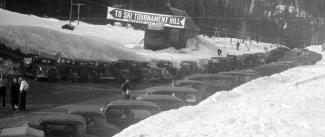Pro vs. Am: Class Warfare in Early American Ski Competition

Patrician attitudes initially dominated 20th-century sports.
In the late 1800s, professional sports attracted high-stakes gambling. The potential for bribery and extortion led to a general sense that paid athletes were corruptible and competitions untrustworthy. While betting on amateur events was common, a deep divide emerged between “pure” amateurs, who were said to compete for the love of the sport, and professionals, who competed for money in the form of cash prizes or other remuneration. The distinction often boiled down to so-called gentleman-athletes, who had private fortunes, versus working-class athletes, who had to earn money to live and train. Sport governing bodies consisted almost exclusively of gentlemen, who often preferred not to compete with working people.
Photo, top of page: Ski jumping became a spectator sport, drawing huge crowds. Ski clubs sold tickets, and athletes wanted appearance money. Thus was born, in 1929, a professional ski jumping circuit. Photo courtesy Washington State Dept of Transportation.
Please subscribe to see article content.
